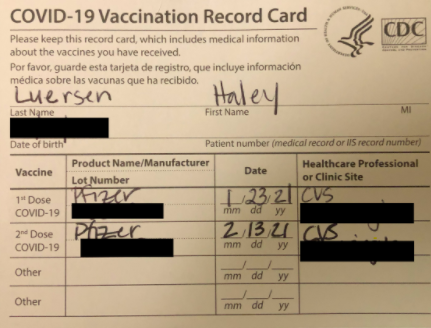Combatting the Pandemic: My experience receiving the COVID-19 vaccine

My COVID-19 Vaccination Record Card that includes information about my specific vaccine.
On January 23, 2021, I received my first dose of the COVID-19 vaccination. I work at an assisted living facility, which means I am surrounded by individuals who are at increased risk for severe illnesses from COVID-19. Due to these risks, the residents and staff of the facility were offered the Pfizer vaccine before the general public.
This vaccine is the best possible way to keep the people around me, and myself, safe from this virus. It was a serious decision I had to make, but I have no doubt I made the right choice. Students and staff at Highlands who have also received the vaccine believe they have made the right decision as well.
“I got vaccinated because of my job and for the safety of myself and my family,” said my coworker, junior Sydney Stubbs.
I received this vaccine for several reasons. First of all, this vaccine will help keep me from contracting COVID-19. Every vaccine that has been approved by the Centers for Disease Control and Prevention (CDC) has been shown to be highly effective in preventing the virus. Yes, there are still many questions surrounding whether or not the vaccine could prevent the virus completely. However, many clinical studies have shown that even if vaccinated individuals were to contract COVID-19, they would not become seriously ill.
Knowing that, not only am I keeping myself safe from COVID-19, but I am also protecting others. If I were to become sick from the virus, I could spread the contagious disease to my family, friends, classmates, etc., which could be detrimental to their health. Therefore, by diminishing the chance of myself contracting the virus by receiving the vaccine, I am also diminishing the chance of spreading it.
The COVID-19 vaccines developed in the past year have been nothing but extraordinary. Highlands biology teacher Matthew Ewald explained to me the fascinating science behind mRNA vaccines.
In short, Ewald described that “the mRNA vaccines…work by informing our immune system about one specific part of the Sars-Cov-2 virus, so that our bodies can easily recognize the virus and fight infection.”
Eventually, the vaccination creates an antibody response when the immune system is faced with the virus without experiencing a sickness. For a more in-depth explanation of the COVID-19 vaccine by Ewald, click here.
The process of getting vaccinated started out more complicated than a seasonal flu shot due to its newness but was not overly stressful. Before receiving the shot, my parents and I had to complete paperwork regarding such things as my medical history and consent to the vaccination. At my first dose appointment, I presented this information to the nurses managing the clinic and received a small card with proof of my vaccination. I was instructed to bring this card to my second dose appointment and to never lose it thereafter as some believe this card will be required for future endeavors. After checking in, it was time for my shot.
Receiving the actual shot was just the same as any typical vaccination—just a poke in the arm. In my opinion, the COVID-19 vaccine hurt less than a flu shot. As expected, I experienced some soreness from my first dose, but that just proves my body reacted to the vaccine the way it was supposed to.
Stubbs had a similar experience after her first dose, stating, “My arm felt like it was 20 pounds, especially when extending it.”
Adhering to the Pfizer vaccine guidelines, I received my second dose of the vaccine on February 13, three weeks after my first. I checked in, presented my vaccine card to the clinic nurse, and made my way to the vaccination room. Similar to the first dose, this shot was hardly painful. However, the nurses warned me that I was likely to experience symptoms, such as aches and pains, around 12 hours after the initial poke. I had heard of a few people who had experienced little to no symptoms, so I had hoped for the same. Unfortunately, this was not the case.
Almost exactly twelve hours after the clinic, I began feeling feverish. I had aches and pains over my entire body, felt chills, and became nauseous. I knew all of these symptoms were normal, but I had not expected to feel as bad as I did. The next day, my symptoms had disappeared, with the exception of a sore arm and fatigue. Some who also received the vaccine, however, had a more positive experience.
“My second dose experience was even better than the first,” remembered Highlands Spanish teacher Emily Haffey. “I worked out the morning before, and I think that helped. I wasn’t even tired from the shot.”
There is a surge of misinformation and disinformation about this vaccine spreading across the internet that is causing many individuals to be wary about receiving it. However, the known and potential benefits of the vaccine outweigh the known and potential risks of the vaccine. I understand that the newness of this vaccine can be scary, but the routine processes that go with any vaccine remain in place to ensure the safety of each COVID-19 vaccine before it is approved for use. It is safe.
Even though I had a not-so-pleasant experience, my feelings towards this vaccine stand the same. Based on the current state of our lives, the COVID-19 vaccine is essential to the health of all people and is the most efficient way the world can return to “normalcy.” I highly encourage everyone to receive this vaccine when it is available to you. Together, we can combat this virus.
Your donation will support the student journalists of Highlands High School. Your contribution will allow us to cover our annual website hosting costs.


